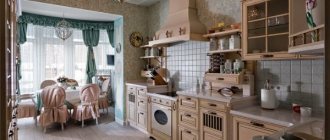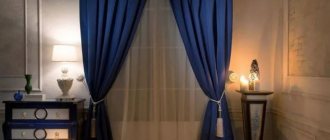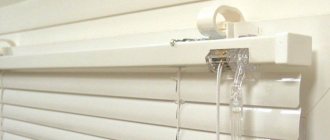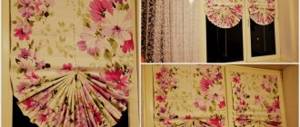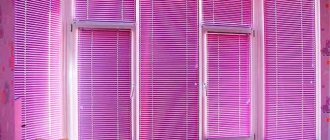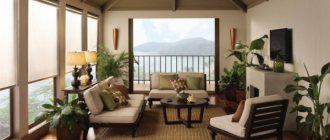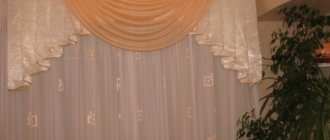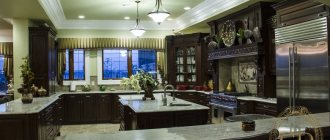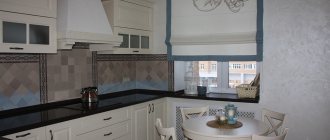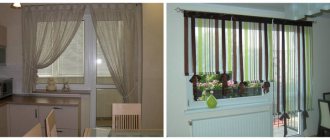So that you can choose the most suitable blinds for the kitchen, we bring to your attention a complete list of their varieties and a voluminous selection of photos of modern interiors.
Interesting facts: the word “blinds”, the sound of which reveals its French origin, is translated as “jealousy” or “envy”. Apparently, once upon a time, blinds prevented not only light, but also the appearance of these unpleasant feelings.
And here is another news for those who consider blinds a product of modernity. They began to be produced at the end of the 18th century, but prototypes of blinds adorned windows back in the Middle Ages, and it is possible that much earlier.
Which is better - blinds or curtains?
These are not mutually exclusive concepts, because one window can contain both, as in the photo.
Blinds perform a practical function, blending in color with the walls or slopes, while curtains have a purely aesthetic purpose. But curtains do not allow “dosing” the lighting.
In addition, not all types of curtains:
- attached directly to the window;
- reflect sunlight, keeping you cool in hot weather;
- prevent the penetration of frosty air in winter;
- will allow you to open the window wide without unnecessary movements;
- cleaned with a vacuum cleaner;
- act as modified shutters;
- fit organically into a kitchen decorated in a modern style.
Now let's compare the disadvantages of blinds and curtains. The disadvantages of blinds are considered to be the possibility of breakage of the control mechanism, as well as thin plates during wiping. But you must admit, anything can be broken. Purchasing blinds from a bona fide, trusted manufacturer and handling them with care will help you avoid this.
On the other hand, curtains are also vulnerable. They tear, deteriorate after washing, shrink, become deformed, fade, and long and light models flutter and are easily flammable, which certainly does not threaten the blinds.
Beautiful blinds, like curtains, will be the main decoration or an inconspicuous addition to your kitchen. And thanks to a wide range of materials and colors, blinds easily fit into any interior style. Don't believe me? Well, we will soon convince you.
Roller blinds
A single canvas that neatly rolls up - that’s what roller blinds are.
The main advantage of roller blinds is the ability to apply various designs to their surface. If you look at the photo of kitchen blinds, these may be motives chosen specifically for this type of room.
Aspects of choosing cookware for an induction cooker
Design of a combined kitchen-living room: zoning and styles (110 photos)
How to decorate walls inside a house - the best ideas, materials and examples of use with photos
And due to the fact that the material from which roller blinds are made is solid, they perfectly protect against the penetration of sunlight.
However, roller blinds have their drawbacks. They absorb odors very quickly, but at the same time they are very difficult to clean, and besides, roller blinds cannot be washed.
It is worth noting that roller blinds must be installed correctly initially. Indeed, if they are installed not on the profile, but on the window frame, then subsequently you will not be able to open the window.
Roller blinds will fit perfectly into an oriental-style kitchen. They can be combined with sheer curtains, creating a festive atmosphere.
Types of blinds
Modern blinds differ from each other in the following parameters:
- plate arrangement - vertical or horizontal;
- materials - fabric, plastic, aluminum, paper, wood, leather, bamboo;
- colors – plain, color, gradient, photo printing;
- level of transparency - varies from translucent to opaque;
- components - plates, slats, panels, lamellas, strips or solid material;
- control method - mechanical (manual) or electronic;
- type of installation - to the upper slope, to the wall, to the ceiling, on the sash, inside the sash, with or without drilling.
Basic recommendations for choosing blinds for the kitchen
Today, the construction market offers a wide variety of types of blinds, which differ in the material used to make the slats (fabric, plastic, wood, metal), their location (horizontal, vertical), control method (mechanical, manual, automatic), fastening system, texture, print, etc. surface color.
According to the type of location, blinds can be horizontal or vertical
The kitchen is a special room with a specific microclimate, which is characterized by high humidity, food odors in the air, and grease and soot settling on furniture and decorative accessories. Taking these factors into account, you should take a very responsible approach to choosing blinds for the kitchen, since not all products can be used in a given room.
Blinds should have a moisture-resistant surface, be easy to clean from dust and dirt, without losing their original appearance. For the kitchen, preference should be given to structures made of metal and plastic, since they are not able to absorb odors. You can buy blinds for the kitchen made of wood. In this case, it should be taken into account that the surface of the lamellas should be laminated, this will allow the product to retain the color longer and absorb odors less. When choosing a design, special attention must be paid to the control mechanism, which must be reliable, durable and function reliably during intensive use.
Blinds can be perfectly combined with other options for curtains and curtains
Blinds should be installed on each window sash separately in order to be able to open them to ventilate the room, which will be problematic to do if there is a solid canvas. When choosing horizontal structures, the length of the lamellas should not be more than 200 cm so that the elements do not bend under their own weight. Such blinds will have to be washed much more often than vertical products.
Vertical
Appearing much later than traditional horizontal models, vertical blinds quickly gained popularity. They look like curtains that have been cut into strips and connected with cords, which makes such blinds more functional.
The width of the lamellas corresponds to two standards:
- American - approximately 9 cm;
- European - approximately 13 cm.
Like a curtain, you can move vertical blinds to the left or right, or extend them to either side from the middle, like curtains. Most often they are made from special fabrics; plastic, aluminum or wooden models are less common. Blinds of this type allow air to pass through well and protect the room from the scorching sun.
Compared to other models, vertical blinds take up more space, but they also:
- better air permeability;
- accumulate less dust;
- visually raise the ceiling;
- ideal for wide windows;
- provide more opportunities for unusual design;
- used instead of doors in studio apartments.
Such blinds are attached to the upper slope of the window, to the wall or ceiling, covering only the window opening or the entire wall.
Single-color, two-color, gradient or colored slats will complement the color scheme or combine the main tones of the interior, which is clearly visible in these photos.
The slats of vertical blinds are not limited to the same length and texture.
Multi-textured
Fashion of 2020 continues to “squeak” on the topic of combining textures and materials, and multi-textured models have become a reflection of this trend in the world of blinds.
Combinations of lamellas of different lengths, colors and materials, smooth and embossed textures allow you to create interesting compositions, examples of which are waiting for you in the photo below.
Multi-textured blinds perfectly imitate voluminous drapery or beautifully folded fabric with a contrasting lining. They will become practical, more suitable for the kitchen, a replacement for weighty compositions made of tulle, curtains and lambrequins and are suitable for rooms in a classic style.
These blinds are more suitable for decorating large windows or balcony blocks.
Arches, semicircles, triangles, zigzags, smooth or abrupt transitions - this is just the tip of the iceberg. Using just two colors, you can decorate the window with a design - a sun, clouds, a flower, a smiley face or an ornament.
The variety of images and combinations of slats of different lengths makes multi-textured blinds an excellent way to realize amazing ideas.
Thanks to a large selection of textures, colors and shapes, you can easily complement kitchen furniture, textiles, and other furnishings. But this is enough for originality, color and texture harmony in the interior.
Color spectrum
If you are choosing which blinds are best for the kitchen, then you should pay attention not only to the material from which they are made, but also to the color and texture. Of course, every housewife will choose the color of the slats that she likes best. But still, you shouldn’t go against the general style of the room. For windows facing the north side, where there is little sun, you should choose blinds in warm colors, but for the sunny side, a cool palette would be the best option.
In addition, you should pay attention to what design allows you to use blinds. They will look organic in a kitchen decorated in an oriental or high-tech style. Especially if you additionally hang light tulle or transparent curtains on the window. The design of the room will sparkle with all the colors and will look truly magical.
Horizontal
Blinds that rise from bottom to top are called horizontal or Venetian. This variety, which has already become a classic, is not inferior to the previously described models in diversity and has its own advantages.
Horizontal blinds adjust the proportions of the room, visually expanding narrow window openings and walls, freeing access to the window sill and are suitable for wooden or plastic windows.
They can be seen in offices, public institutions, apartments, as well as in private houses, both on the inside and outside of the windows.
Unlike vertical models, horizontal blinds are installed:
- on the window sash, which allows you to open each window;
- inside the window opening, which is more suitable for decorating blind windows;
- between the glasses, inside the glass unit, which protects them as much as possible from external influences and saves space;
- on the outside of the windows, making them part of the security system.
When lifted, the slats are pressed against each other, folded and hidden in a special box (cassette). The colors of the plates and the box may differ, in harmony with other two-color interior details. The width of the lamellas depends on the material and can range from 16 to 50 cm.
Tip: if you have wooden casement windows, the cassette located on the sash may interfere with opening the window. In this case, it is better to choose a different fastening method or, as an option, to space or move the slope.
In addition to different installation options, horizontal blinds also differ in materials of manufacture.
Horizontal blinds for the kitchen: photos of interesting models
Curtains with horizontal slats are the most popular type of blinds. Photos of room design clearly display various window design options. This is the most optimal solution for small kitchens with small windows, since they do not overload the interior and do not steal scarce space due to their compact design. The maximum effect is achieved when using inter-frame models that are mounted in the intra-frame space between the glass, leaving the window opening and window sill completely free. The products are easy to use.
Horizontal blinds are the most popular and are optimal for small windows
The lamellas are located parallel to each other. The elements can be controlled using thin ropes located between them, so you can direct the solar flow up or down. The main advantage of such structures is the guarantee of absolute darkness of the room when the blinds are closed, which is especially important for kitchens located on the south side.
Horizontal slats are made of wood, bamboo, plastic and aluminum. For the kitchen, it is better to choose the last two product options, since they do not absorb odors, are not exposed to moisture and are easy to clean. Manufacturers produce canvases in a variety of colors. Here you can choose a single-color, two-color, perforated, wood-imitating model.
For the kitchen, it is better to choose blinds made of plastic or metal, as they are easier to care for and do not absorb odors.
Horizontal blinds made of plastic or aluminum fit organically into the interior of a room decorated in a high-tech and minimalist style. If the kitchen is made in a classic design, eco-style, country or Provence, it would be appropriate to use wooden or bamboo products that will emphasize the naturalness of the stylistic direction. In spacious rooms they can be harmoniously complemented with other curtain options: drapes, tulle and lambrequins, adapting the products to any interior.
When buying blinds, it is better not to save money, since the control mechanism must be of high quality
The main disadvantage of horizontal products is that dirt and dust settle on them faster, so they need to be washed quite often, at least 1-2 times a week.
Aluminum
From a practical point of view, this material is ideal for the kitchen. It is durable, lightweight, indifferent to moisture, heat, ultraviolet radiation, temperature changes, easy to care for and inexpensive.
Since aluminum does not deform, blinds based on it can be hung on windows that have a sink or stove.
In aesthetic terms, aluminum blinds benefit from a wide color palette and successful imitations - for example, wood, chrome, brick, gold or silver. This makes them universal and suitable for any style direction - from hi-tech and minimalism to country and neoclassical.
White blinds that merge with the window frames will become a wonderful backdrop for contrasting patterned tulle, although they will cope well with a solo party.
And plates in gray or beige tones will be a harmonious continuation of walls of similar colors.
Interframe
They are one of the options for horizontal blinds, only they are attached between the frames. Suitable for both wooden and plastic windows. Advantages:
- all opening functions and slat adjustments are retained,
- horizontal lamellas do not gather dust, do not get dirty with grease, and always remain in their original form,
- Ideal for small kitchens, they do not take up a single centimeter of kitchen space.
Below we will consider possible materials.
Plastic
Lightweight, practical, inexpensive plastic material. This type of blinds is a budget and stylish option.
Aluminum
Aluminum blinds can always be recognized by their metallic color, from natural silver to tinted. Aluminum slats go well with metal surfaces of kitchen appliances.
Using paint spraying, it is possible to coat light aluminum parts in other colors: white, gray, beige.
Suitable for strict, conservative people who are in love with modern high-tech style and minimalism. Also, aluminum blinds are resistant to high humidity, wear-resistant, fire-resistant, and durable.
Wooden
Modern models are adapted for kitchens, thanks to a protective film specially applied to each lamella. The coating protects the wood from moisture, but it’s hard to call them 100% environmentally friendly, and yet they are safer than plastic models.
They go perfectly with wooden countertops and facades and harmoniously complement Provence, country, and rustic styles. Requires careful care.
Fabric
This textile combines natural and synthetic fibers with moisture-proof impregnation. They do not fade in the sun, the design remains for many years.
Isotra (Price-Hit) and Isolite
These are the most common types of horizontal aluminum blinds, which are considered the best solution for lovers of indoor plants or compact window decor.
They are suitable for wooden and plastic windows, fit closely to the sash and do not change their position due to a draft or when the ventilation mode is tilted.
The big advantage of this type of blinds is single-command control - instead of two or several constantly tangled cords, you use one ball chain.
Plastic
Plastic is another material suitable for the kitchen. Plastic blinds are no less diverse and are in no way inferior to the previous ones in terms of colors and number of imitations.
Wear-resistant, lightweight and durable, they are in great demand due to their symbolic cost. Plain blinds can match the colors of the walls, furniture facades, tables, chairs or floor coverings.
Plates of two or more colors will combine all the colors present in the interior on one plane. You can admire the variety of colors of plastic blinds by looking at these photos.
Wooden
Wooden or chipboard blinds are a luxurious and environmentally friendly window decoration that harmonizes perfectly with furniture, cabinets and other wooden interior items.
Wood is not friendly with high humidity and dryness, which causes it to become deformed and lose its attractiveness. However, if the windows are far from the sink or stove, and even more so if there is good ventilation or climate control, such window decor will come in very handy.
In addition to cords or ropes, braid is used to fix and raise horizontal wooden blinds, which will complement the textile elements and color scheme of the interior. As you understand, there are also vertical models.
Recommendations for decorating a kitchen window
The selection of products depends on the area and style of the room:
- For a small kitchen, white or beige blinds are suitable; they do not attract attention and reflect sunlight. In large kitchens you can use both light and dark shades.
- To visually raise the ceiling, vertical structures are selected.
- To expand the space - horizontal slats.
- Various types of blinds suit almost any kitchen interior. Laconic plastic models are appropriate in modern styles, and blinds made of wood or fabric are appropriate in rustic and eco-styles.
See also how curtains look in the kitchen.
Rolled
Roller blinds or roller blinds are a successful hybrid of curtains and blinds, which inherited the best qualities from their “parents”. The beauty of curtains is represented by a variety of fabrics - silk, cotton, linen, acrylic and cellulose, and the practicality of blinds lies in their compactness and control method.
When raised, fabric blinds roll into a neat roll. Roller blinds are also made from bamboo, jute, burlap and other eco-friendly materials, which makes them suitable for any interior design.
Day Night
A recently popular new product is a type of roller blinds. Thanks to the alternation of dense and transparent stripes, you can adjust the level of illumination in the room.
Another plus is the horizontal stripes, which visually expand the window opening. Day-night blinds do not lag behind other models in the richness of colors, but models in bright colors look especially impressive.
Sun protection beautiful blinds day-night
The second name for day-night blinds is zebra. This is due to the design features of the product, which combines the advantages of horizontal curtains and roller blinds. The system is made of double fabric, where transparent and opaque stripes alternate with each other. Opaque fragments are made of dense three-layer textile (blackout), which does not transmit light.
Zebra blinds look not only stylish, but also self-sufficient
The control mechanism for blinds is the same as for roller blinds. A roller is also used here. However, the fabric is not wound around it, but is thrown to the other side. As a result of such movement, it is possible to achieve the combination and alternation of dense and transparent stripes, which allows you to regulate the flow of light, achieving the required level of illumination in the room.
Performing simultaneously the function of curtains and drapes, day-night blinds are self-sufficient. They should not be combined with other types of curtains. This type of blinds is ideal for modern interiors where there is no sign of antiquity: modern, high-tech, eco-style, minimalism. However, if you skillfully choose the picture of the blinds, they can be adapted to French Provence, American country or English shabby chic.
Roman
Roman blinds can also be called fabric blinds. They differ from the previous ones in the beautiful folds that form when lifted. The difference is that due to the assembly of the folds, you will not be able to completely expose the window. Decorative drapery and a wide choice of fabrics open the door for Roman shades to many traditional design styles. Products made from jute or bamboo are perfect for Eastern, African, ethnic and eco-inspired designs.
Blinds for the kitchen: existing materials
There are so many things that blinds are made from – plastic, all kinds of fabrics, metals, bamboo and wood. Let's look at what materials modern designers choose.
Fabric blinds
Just a few years ago, many interior designers tried to choose blinds made of aluminum, wood or plastic for their homes, but today everything has changed. The fabric slats sat on their pedestal with dignity and settled there for a long time. This type of material is distinguished by its moisture resistance, thanks to treatment with specialized compounds, and the repulsion of dust and other contaminants due to antistatic treatment.
But it is not recommended to rub a dirty spot on the slats themselves; it is better to unhook the weights from them, roll them into rolls and place them in a liquid with a soap solution. After a while, when the dirt has come off, carefully rinse each of the slats and hang them back straight in the wet state, picking up the weight.
If your blinds are made of fiberglass, then they will not only be practical when cleaning them (just wipe with a damp sponge), but will also keep your home safe, because they are fireproof and will not allow the fire to spread in the event of a fire.
Fabric blinds can add comfort and aesthetic completeness to your interior, but they have one small drawback - they are exclusively vertical. This more than pays off with the variety of colors, textures and images on them. The main materials were linen, cotton, fiberglass and jute.
“A few years ago, many interior designers tried to choose blinds made of aluminum, wood or plastic for their homes, but today everything has changed. The fabric slats sat on their pedestal with dignity and settled there for a long time.”
Wooden blinds
In the 18th century, in Western Europe, blinds were made mainly from various types of wood. But now everything is completely different... They have become a luxury rather than an ordinary type of blinds, due to the high cost of the material. You can endlessly describe the beneficial properties of wood, but I will focus on the most important thing - products made from it are not only beautiful and pleasant to the touch, but also environmentally friendly. They bring a unique feeling of warmth and comfort to any interior, regardless of the overall style. They look more harmonious in country style.
Plastic blinds
This type of blinds is the most budget option. But even here there is plenty to choose from - cheaper models are short-lived, they quickly fade in the sun and become deformed, which cannot be said about expensive ones. By paying a little more, you will be convinced of their unpretentiousness - dirt and odors will not affect them, they will serve you for many years, carefully preserving the comfort and style of your kitchen.
Bamboo
Stylish and environmentally friendly bamboo blinds, roller blinds or Roman blinds will look perfect on the windows of a kitchen decorated in styles such as eco, hygge, ethno, grunge, bionics.
Bamboo is a fairly hardy material that combines the beauty of wood and the durability of plastic. Its wood tones will harmonize with furniture, countertops, lamps and other wooden interior elements.
By hanging bamboo blinds on plastic windows, you will disguise a comfortable, but too modern and contrary to some styles, element of the interior.
What material is best for kitchen blinds?
If you want your kitchen to turn into a home, then pay attention to the window design. Use practical and comfortable blinds in your kitchen interior. Many housewives do not know which ones are best to choose, so let's fill in these gaps.
Nowadays there is a huge selection of blinds on the market, but not all names are suitable for the kitchen.
Plastic
Plastic blinds are very easy to maintain. Their properties are hygienic and they hold their shape perfectly. If the kitchen window is located next to a gas stove or built-in hob, then such blinds will not be suitable. When exposed to heat, the slats may become deformed. They do not absorb kitchen odors, do not sag and dry quickly after cleaning.
Textile
When choosing fabric curtains and blinds for the kitchen, first of all you need to pay attention to the density of the fabric. The denser it is, the longer it will retain its shape. If the kitchen window is located on the sunny side, then there is a possibility that the fabric blinds may fade slightly.
Polyester is used in the manufacture of such blinds.
Tree
Blinds with wooden slats are environmentally friendly and safe for health. They will look great both in the kitchen and in other rooms. The material has a natural pattern. These blinds are reliable and durable, but the cost is higher than others.
They are usually made from durable balsa wood and Canadian basswood. Ideal if the kitchen is decorated in country or eco style.
Aluminum
Horizontal blinds are made from this material. They are coated with a special compound that protects them from direct sunlight. They are very easy to care for, as they are easy to wash and clean. These blinds are suitable not only for the kitchen, but also for other rooms.
Cassette
Cassette blinds practically merge with the window, becoming one with them. They will be an ideal solution for sloping attic windows. Cassette models will fit in a small kitchen, where the window sill acts as a working surface, and the slopes are occupied by shelves with dishes or indoor plants.
The base can be fabric, aluminum, plastic or film with an image. By the way, you will admire it during the daytime, and your neighbors will admire it in the evening.
Colored
Colored horizontal or vertical blinds are a colorful decoration that will become a source of your good mood for a long time. They will enliven a monochrome interior or combine all the bright accents.
For windows with several sashes, you can come up with an endless variety of symmetrical and asymmetrical compositions, alternating single-color blinds with two- or multi-color stripes.
With photo printing
Photo printing can be applied to vertical or horizontal blinds. A sunrise, a morning forest, an endless field, the lights of a metropolis, a seascape or a memorable photograph - on the windows there will be everything that you are ready to admire forever. When it comes to fashion trends, abstract images are trending.
If the landscape outside the window does not please you, just replace it with blinds. To visually enlarge small spaces, it is better to use images with perspective. Blinds with photo printing are a great idea for decorating bay windows and balconies.
Pleated
Pleated blinds are unique and unlike other varieties. Pleated curtains:
- folds according to the accordion principle;
- suitable for windows of non-standard shape;
- fold not only up, but also down.
Pleated curtains are made from synthetic fabrics - for example, polyester, fiberglass or paper. According to the level of fixation, they can be free-hanging or fixed.
Paper blinds are cheap and short-lived, but they are a great motivation for a change of scenery and an opportunity to make something for your home with your own hands. If you are looking for something more wear-resistant, pay attention to fabrics impregnated with dust-repellent additives or fiberglass.
Pleated blinds covering semicircular windows look like an open fan and give the room an elegant, unusual look. By dividing a tall rectangular window into equal parts, you can decorate each of them with pleated blinds of the same or different colors.
Like other types of horizontal blinds, pleated blinds have varying degrees of transparency and a huge range of colors, as these photos will confirm.
Photo of blinds in the kitchen
Note! Yellow kitchen: advantages and disadvantages of kitchen design with a yellow tint (75 photos)
Let's discuss this article together:
Click to cancel reply.
Wave
Vertical or horizontal “Wave” blinds are one of the latest innovations in window decor. If you are a supporter of soft lines and smooth transitions, this model is exactly what you need. It is believed that such blinds scatter light in a natural way, like tree foliage, and change appearance depending on the lighting. “Wave” blinds will fill the room with a play of shadows, create the illusion of additional volume and act as the main accent of the room.
With this we will say goodbye. We hope you didn’t get lost in the jungle of choices and found what you were looking for!
